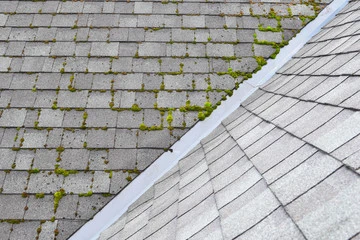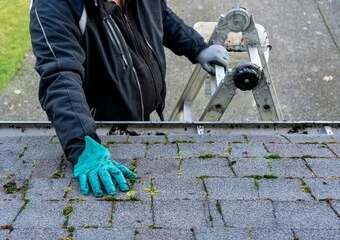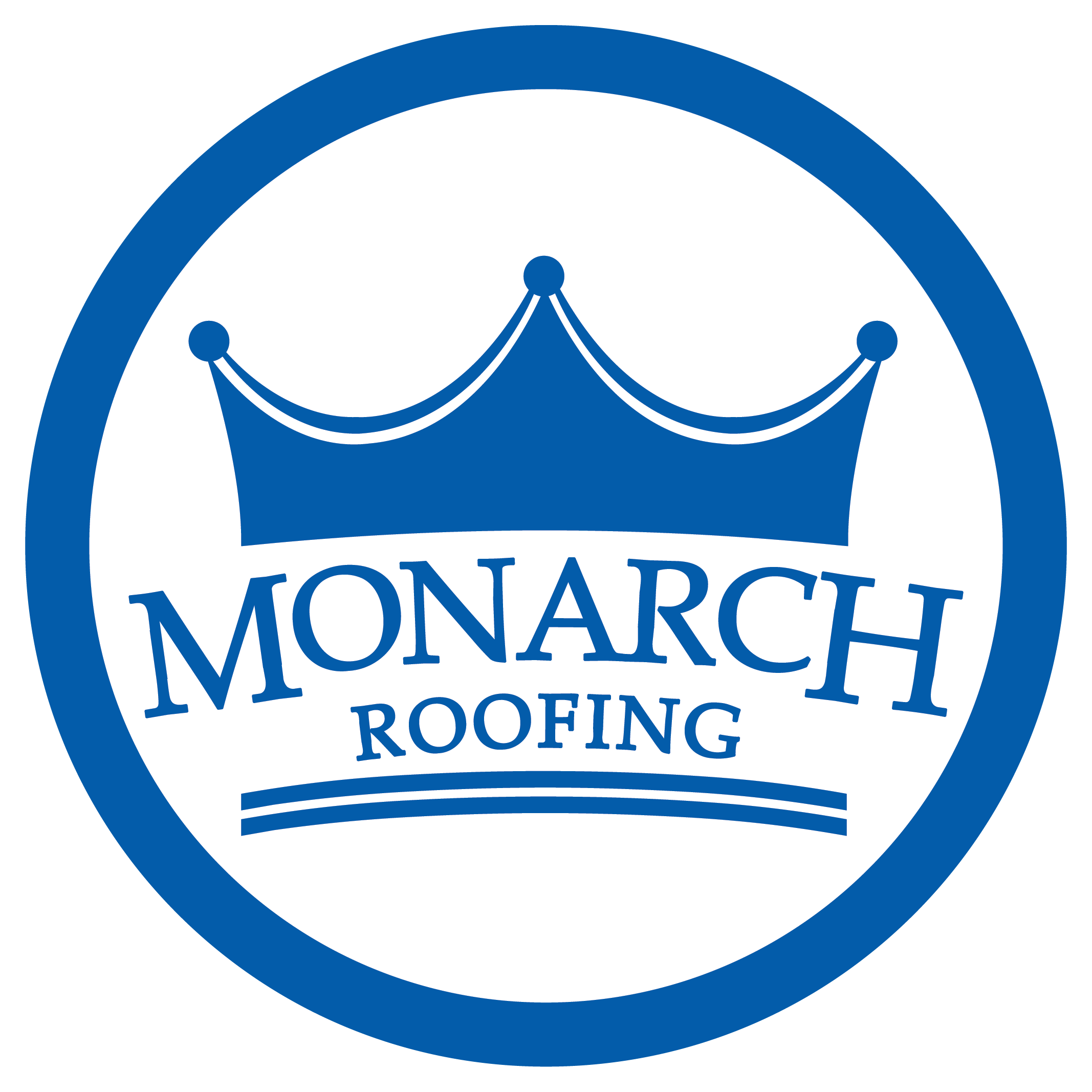A well-maintained roof is vital for the longevity and overall health of your home. One common issue that homeowners face, especially in damp or shaded environments, is the growth of moss on their roofs. While a little bit of moss might seem harmless, it can lead to significant damage if left unchecked. This guide will walk you through everything you need to know about roof moss removal, including:
- Understanding roof moss
- When to clean your roof
- How to clean your roof in 9 steps
- When to repair your roof
- When to replace your roof
- Professional installation
🤔 Understanding Roof Moss

Moss is a small, non-vascular plant that thrives in damp, shaded environments. It tends to grow in clumps and can quickly spread across surfaces like roof shingles. Moss retains moisture, which can lead to significant damage to your roof over time.
- Moisture Retention: Moss holds moisture against the surface of your roof, which can cause shingles to deteriorate and wood to rot.W
- Weight and Growth: As moss grows and spreads, it can add weight to your roof, potentially causing structural damage.
- Shingle Displacement: Moss can lift and displace shingles, allowing water to seep underneath and cause leaks.
- Aesthetic Damage: Beyond structural concerns, moss-covered roofs can look unsightly and affect your home’s curb appeal.
🧼 When to Clean Your Roof
Regular Maintenance: Regular maintenance is crucial for preventing moss growth. Here are some signs that it might be time to clean your roof:
- Visible Moss: Any visible signs of moss should prompt immediate action. It’s easier to remove when it’s just starting to grow.
- Debris Accumulation: Leaves, twigs, and other debris can create a damp environment that encourages moss growth.
- Shingle Discoloration: Dark streaks or patches might indicate moss or algae presence.
Seasonal Considerations
- Spring and Fall: These are ideal times for roof cleaning, as the weather is generally mild. Spring cleaning removes moss that has accumulated over the winter, while fall cleaning prepares your roof for the wet season.
- After Heavy Rains: Heavy rainfall can create perfect conditions for moss growth. Inspect your roof after prolonged rainy periods.
💡 How to Clean Your Roof In 9 Steps

Cleaning your roof is essential for maintaining its longevity and curb appeal. In this section, we’ll walk you through a straightforward, nine-step process to ensure your roof remains in top condition.
1. Protective Gear
Wear gloves, safety goggles, and non-slip shoes.
2. Ladder Safety
Ensure your ladder is stable and placed on a flat surface. Use a ladder stabilizer if possible.
3. Avoid Roof Damage
Be cautious to not damage the shingles while cleaning.
4. Manual Removal
Use a long-handled brush or broom to gently scrape off moss. Avoid using a pressure washer as it can damage shingles.
5. Chemical Treatments
There are commercial moss-killing solutions available. Apply these according to the manufacturer’s instructions and rinse thoroughly.
6. Homemade Solutions
A mix of water and bleach (50/50) or water and vinegar (70/30) can be effective. Spray the solution on the affected areas, let it sit for about 15-20 minutes, then scrub and rinse off.
7. Trim Overhanging Branches
This reduces shade and allows more sunlight to reach your roof, making it less hospitable for moss.
8. Clean Gutters
Ensure gutters are clean and free-flowing to prevent water backup.
9. Copper or Zinc Strips
Installing these at the roof ridge can help prevent moss growth. Rainwater leaches small amounts of metal, which inhibit moss formation.
🏠 When to Repair Your Roof
Identifying Damage: Even with regular cleaning, moss can cause damage over time. Here’s when you might need to consider repairs:
- Shingle Damage: Look for curled, cracked, or missing shingles.
- Leaks: Water stains on your ceiling or walls indicate a possible leak.
- Structural Damage: Sagging roof sections can be a sign of significant damage.
Repair Methods
- Replacing Shingles: Damaged shingles should be replaced immediately to prevent further damage.
- Sealing Leaks: Small leaks can often be sealed with roofing cement or a similar product. Larger leaks might require professional intervention.
- Fixing Flashing: Ensure the flashing around chimneys, vents, and skylights is intact and secure.
Professional Help: If the damage is extensive or you’re unsure about the repair process, it’s best to hire a professional roofer. They can assess the extent of the damage and recommend the best course of action.
🏚️ When to Replace Your Roof
Knowing when to replace your roof is crucial for the safety and value of your home. Regular inspections and understanding the signs of wear and tear can help you determine the right time to invest in a new roof.
Signs You Need a New Roof
- Age: Most roofs last between 20-25 years. If your roof is older, it might be time to consider replacement.
- Widespread Damage: If more than one-third of your shingles are damaged or missing, a replacement might be more cost-effective than continual repairs.
- Repeated Leaks: Persistent leaks despite multiple repairs are a sign that your roof’s integrity is compromised.
- Moss and Algae: Extensive moss and algae growth can indicate underlying issues that might necessitate a full replacement.
Choosing a New Roof
- Material: Consider materials like asphalt shingles, metal, tile, or slate. Each has its pros and cons in terms of durability, cost, and appearance.
- Climate Suitability: Choose a material that suits your local climate. For example, metal roofs are excellent for areas with heavy snowfall, while clay tiles are ideal for hot, dry regions.
- Energy Efficiency: Modern roofing materials can improve your home’s energy efficiency, helping you save on heating and cooling costs.
🧑🔧 Professional Installation
Always hire a reputable roofing contractor for replacements. Ensure they are licensed, insured, and have good reviews. A professional installation will ensure your new roof is installed correctly and will last for years to come.
🙌 Protect Your Home with Monarch Roofing
Maintaining your roof is crucial for protecting your home and ensuring its longevity. Moss growth, though seemingly harmless, can cause significant damage if not addressed promptly. Regular cleaning, timely repairs, and knowing when to replace your roof are key to keeping your home in top condition. By following the guidelines in this comprehensive roof moss removal guide, you can effectively manage moss growth, extend the life of your roof, and avoid costly repairs or replacements. Always prioritize safety, and don’t hesitate to seek professional help when needed. A well-maintained roof not only protects your home but also enhances its value and curb appeal.
At Monarch Roofing, we are the experts you trust for all your roofing needs. Our team is equipped with the knowledge, experience, and tools to handle any roofing issue with precision and care. We are dedicated to providing top-notch service and ensuring your roof remains in excellent condition. Trust Monarch Roofing to keep your home safe, beautiful, and well-maintained. Contact us today for a free inspection!





